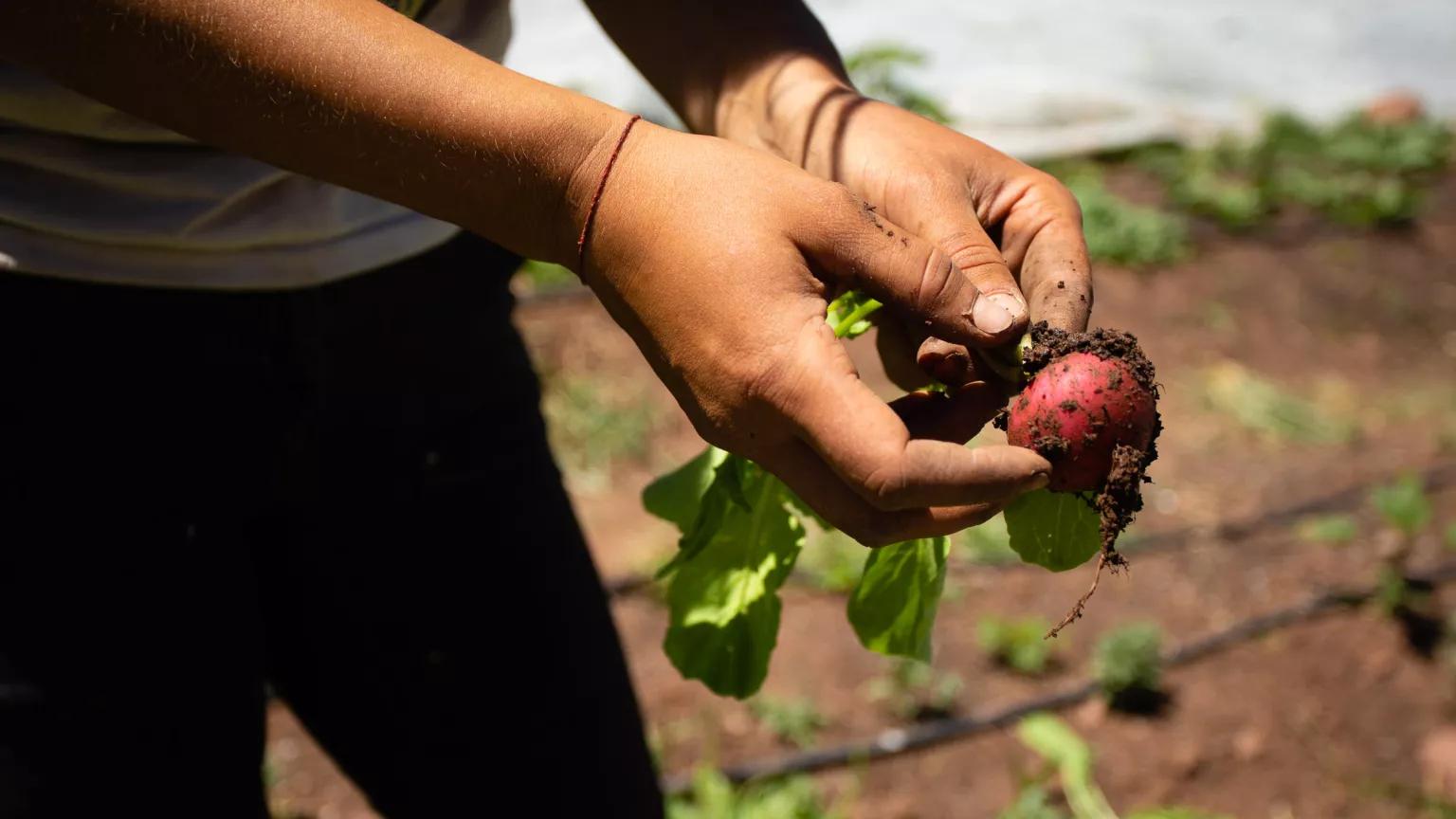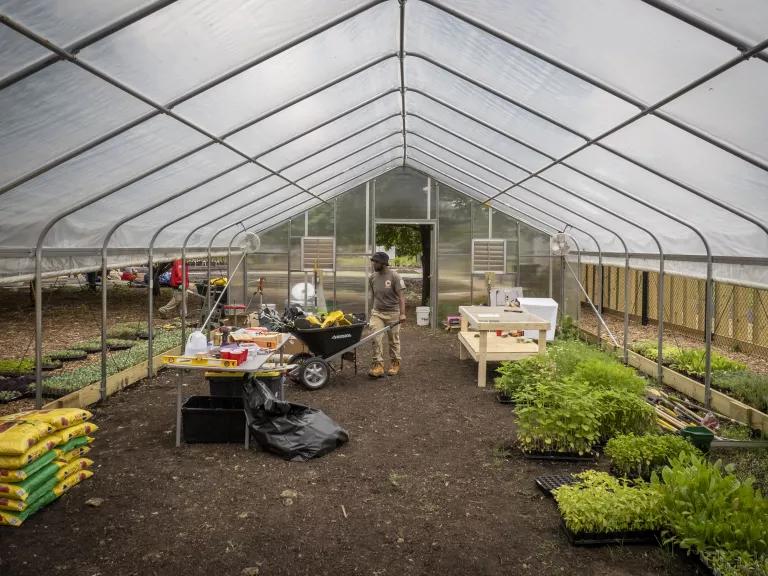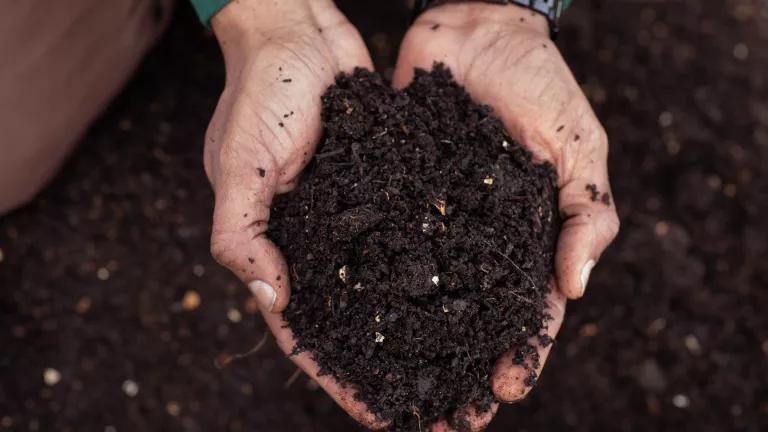
Jeremy Swanson for NRDC
Agriculture & Food
Overview
We need to build a more resilient and regenerative 21st-century food system—one that protects the health of communities, soils, and ecosystems while helping farmers and ranchers adapt to the realities of climate change. To get there, we must step away from modern industrial agriculture and instead grow food using practices rooted in Indigenous wisdom and without toxic chemicals. And we must waste less food to reduce climate and resource impacts, distribute surplus food to ensure all communities are nourished, and compost food scraps to build healthy soil.
Solutions
Climate, food security, and our health are all intimately linked. NRDC is dedicated to strengthening our food system, from farm to table. Here are our current priorities:
Support transitions to regenerative and organic agriculture
Through our advocacy work and publications like Regenerative Agriculture: Farm Policy for the 21st Century, we champion regenerative agriculture to build soil health, limit the use of harmful chemicals, and conserve water and other resources. We’re building a roadmap for lawmakers to coordinate research efforts on soil health and agroforestry, invest in more decentralized and diverse food systems infrastructure, break barriers for BIPOC growers with programs that open the door to organic and regenerative farming, and create pathways to serve organic food in schools and other institutions. We’re also guiding reforms to the Federal Crop Insurance Program, which farmers rely on to manage weather-related risks, to incentivize regenerative land stewardship.
Build soil health to increase resiliency and reduce climate impacts
We’re pushing for policies that encourage farmers and ranchers to keep soil covered by planting more trees, perennials, and cover crops. These grasses, legumes, and other plants protect exposed soil and prevent erosion, suppress weeds, sequester carbon from the atmosphere, and minimize flooding and nutrient runoff (which can trigger harmful algal blooms that pollute our waterways). Adding compost to soil also improves soil health, for example, by adding nutrients and organic matter, increasing water and nutrient retention capacity, and increasing soil productivity and carbon storage. Provisions in major agricultural policies can go a long way toward incentivizing farmers to adopt techniques that boost their soils’ carbon levels while also protecting habitat for biodiversity and growing healthy food.
Did You Know?
Soil may be one of the planet’s most underappreciated natural resources, yet healthy soil is the foundation for agriculture; it also plays a vital role in protecting the air we breathe, the water we drink, the food we eat—and even our climate. So, when we lose it, the ramifications are severe. One inch of topsoil can take several hundred years to develop, and scientists estimate that if current rates of soil degradation continue, all of the world’s topsoil could be gone within 60 years. Luckily, there are many time-tested techniques to help conserve our soil for generations to come.
Rein in pesticide use
Pesticides are harmful to agricultural workers, consumers, pollinators, and our environment. We’re using our litigation tools and policy expertise, as well as building coalitions with farmworker advocates and labor and health groups, to work toward protecting people from toxic pesticides, like chlorpyrifos and other brain-damaging organophosphate pesticides, and glyphosate (a weed-killer often sprayed on corn, wheat, barley, and oats). We are also working to end the unnecessary and destructive uses of neonic insecticides in agriculture and to close major loopholes in the regulation of pesticides in California and across the country, like the one for pesticide-coated crop seeds.
Reduce food waste
NRDC has a long-standing history of uplifting the most impactful solutions to food waste, including through our Save the Food work on household food waste, which is the biggest collective source in the United States. We’re working at every level toward a national goal to cut food waste in half by 2030, an urgent priority given that food production and processing use a tremendous amount of natural resources—water, land, chemicals, and energy—and food in landfills is a major source of the climate pollutant methane. At the federal and state levels, we advocate for programs to help prevent food from being wasted in the first place, rescue surplus food and redirect it to people experiencing food insecurity, and compost food scraps. Meanwhile, our Food Matters project leverages connections between cities to address local solutions to food waste that also bolster community resiliency.
Reform livestock production
Health hazards for animals, people, and the environment are all too common in industrial livestock production. We’ve worked for years to raise awareness and address many of them—from the unnecessary use of antibiotics in livestock that exacerbates antibiotic resistance to the massive manure lagoons created on concentrated animal feeding operations (CAFOs—aka factory farms), which harm nearby communities, poison drinking water, and contribute to epic dead zones in aquatic environments. We are urging the FDA to effectively regulate antibiotic use in livestock. We are also encouraging states to step into the federal regulatory gap left by lax EPA oversight, using an NRDC-developed permit to monitor and regulate CAFOs that endanger the health of nearby communities and the environment. We’re also calling for a broader shift to climate-healthy menus that are plant-rich and rely far less on industrially produced meat and poultry.
Combat food insecurity
Policies that meaningfully increase local power and wealth in our food system—including through support to food service and farm workers, who have some of the lowest-paying jobs in the United States—are crucial to addressing disparities in access to healthy and affordable food. We’re fighting to advance environmental justice in the food system alongside grassroots partners to provide healthier foods to students. We’re also helping states better leverage the Supplemental Nutrition Assistance Program (SNAP) to ensure their residents can meaningfully access sufficient and healthy food while simultaneously supporting smaller-scale local farms, which are an essential part of a thriving regional economy.
“Wizipan Little Elk from the Rosebud Sioux Tribe recently taught me about the Seventh Generation Principle. Born from the Haudenosaunee, the Seventh Generation Principle asks us to think about how our current water, energy, and natural resource decisions affect the livelihoods of people and the planet seven generations from now. At a time when our water, climate, public health, and biodiversity crises are colliding, we must lean on Indigenous leaders and build their wisdom into the foundation of future programming. That’s how we can begin to transition to a 21st-century food and farming system.”
Arohi Sharma, deputy director, regenerative agriculture, Nature Program
Progress
- The Risk Management Agency of the U.S. Department of Agriculture (USDA) is offering a crop insurance savings opportunity to farmers who plant cover crops, utilizing a model NRDC cultivated alongside partner organizations in Illinois, Iowa, and Wisconsin.
- The 2018 Farm Bill included a new Soil Health Demonstration Trial, a program that pays farmers up-front for soil health practices and soil testing as well as a Food Loss and Waste Reduction Liaison to coordinate cross-agency activities to meet the goal of cutting food waste in half by 2030.
- In 2021, the U.S. Environmental Protection Agency finally banned chlorpyrifos, a highly toxic pesticide that harms kids, farmworkers, and their families—and that NRDC advocates and partners had spent decades fighting against.
- NRDC’s advocacy helped create a first-of-its-kind Farm to School program in California, which gives schools extra funding if they buy from local farmers who are using climate-friendly organic practices. We’ve also worked closely with the Urban School Food Alliance to leverage the enormous buying power of its members to limit antibiotic use in the chicken and turkey industries.
- In 2022, the USDA announced a framework for shoring up the food supply chain and transforming the food system to be fairer, more competitive, and more resilient. As part of this initiative, USDA will invest $90 million in Urban Agriculture and Innovation Production to augment the Community Composting and Food Waste Reduction grants over three years and $300 million to support an Organic Transitions Program.
- NRDC helped win legislation in California in 2022 that will establish a pilot $5 million grant program that helps historically underserved farmers mitigate the risk of the three-year transition process to organic certification. The law also helps expand much-needed technical assistance resources throughout the state.
More Ways to Make an Impact
Latest News & Resources
The future of our food supply relies on bees—but they’re dying at an alarming rate.
Demand that the EPA ban bee-killing uses of neonics once and for all!

Urge the EPA to ban neonics—and save our pollinators and the future of our food supply!
View All Issues

Climate Change

Equity & Justice

Human Health


















